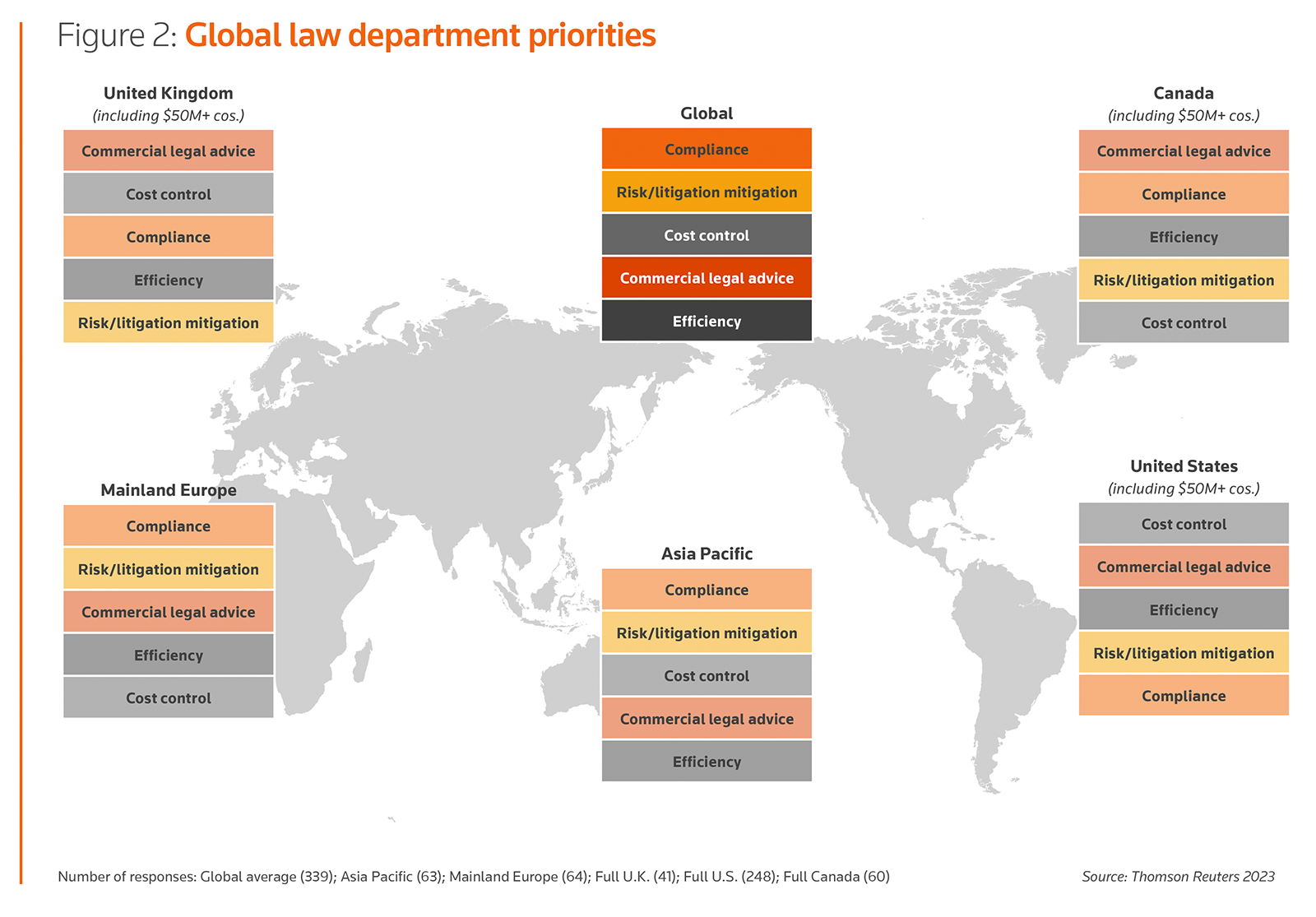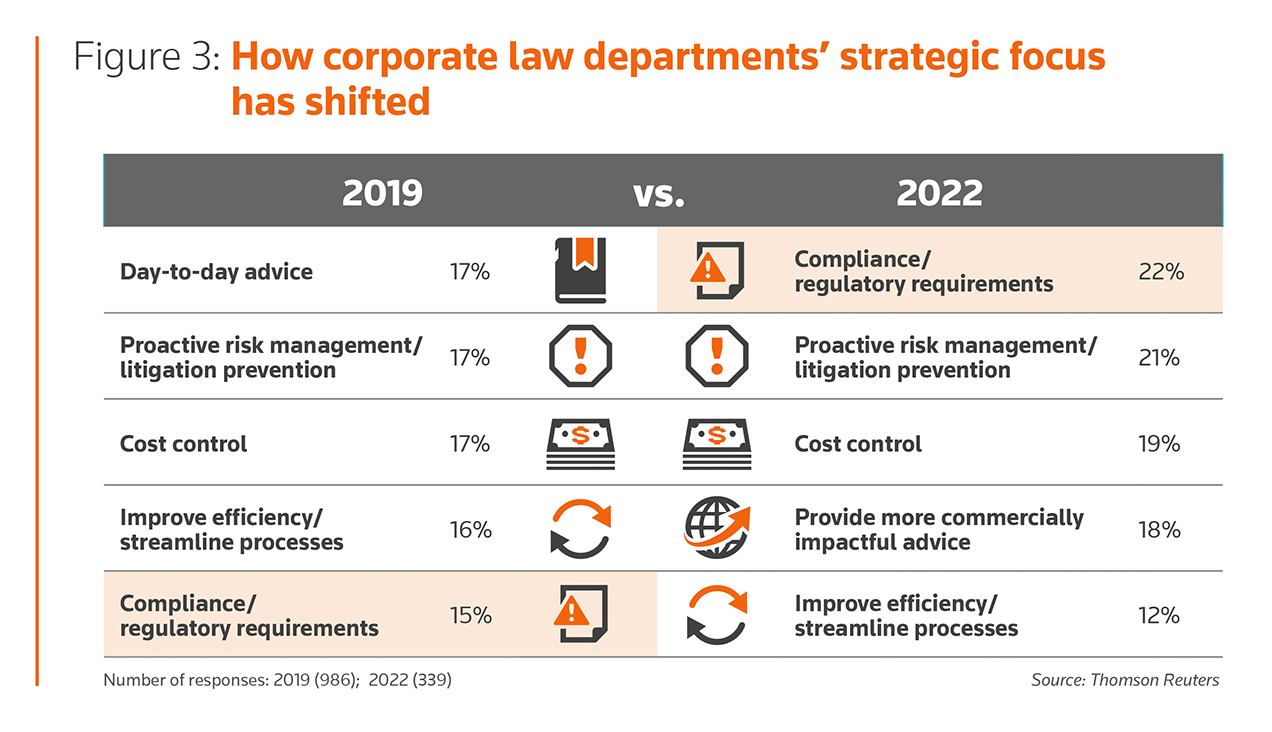A more complex and changing regulatory landscape may cause sleepless nights for in-house legal teams, but it may provide opportunities for some nimble law firms and ALSPs
The recently released 2023 State of the Corporate Law Department report from the Thomson Reuters Institute provided a great deal of coverage around the rising level of concern among corporate law departments regarding increasing regulatory complexity. Globally, compliance is the number one law department priority; in fact, no region of the world saw compliance fall outside the top 5 priorities for corporate law departments.
Since 2019, compliance has seen a noticeable upward shift among corporate law departments’ strategic focus. While roughly 15% of respondents listed compliance as an area of strategic focus in 2019, that number increased to 22% by the end 2022.
Law departments realize that this shift in mindset does not come without cost. More than one-third (36%) of corporate law departments surveyed for the report say they anticipate increasing their legal spend on regulatory matters in the coming year, compared to just 8% that expect their spend to decrease in that area. The report also details a metric called net spend anticipation (NSA), which reflects the number of respondents expecting a decrease subtracted from those expecting an increase. Regulatory matters saw the highest NSA of any practice reported this year, 10 points higher than the NSA for labor & employment, the next closest practice.

All this suggests that there is a potential boom in regulatory work upon which law firms could capitalize. However, it is very much an open question as to whether law firms are positioned effectively to take advantage of this potential opportunity — or whether corporate clients are even really considering law firms for the work at all.
According to the Alternative Legal Services Providers 2023 report, regulatory risk and compliance services are the top use case that have corporate law departments turning to alternative legal services providers (ALSPs), funneling that work to ALSPs rather than traditional law firms. One-half of corporations surveyed for the ALSP report indicated that they used an ALSP for regulatory risk and compliance services. Indeed, across the globe, use of ALSPs for risk and compliance services was high and seen as likely to grow over the next five years.
Corporate clients are quite clear on why they are choosing ALSPs for regulatory risk and compliance services. A majority of respondents (57%) cited access to specialized expertise as one of the key reasons they use an ALSP for risk and compliance. Clients also look to ALSPs to help drive greater efficiencies and to help free up internal legal teams to work on higher value, more strategic work.

This is not a new finding either, corporate law departments have been citing risk and compliance as a key use case for ALSPs for as long as the report has been produced. Going back to the original ALSP report in 2017, risk and compliance was the top use case for corporate law departments using ALSPs. It has been clear for some time that when it comes to regulatory risk and compliance needs, corporate law departments have a preference for ALSPs.
This creates a potential problem for law firms that are looking to capitalize on any impending surge in regulatory work within corporate law departments. Beyond those corporate clients that already use an ALSP for regulatory work, another 24% expect to be using one within the next five years.
Some law firms are looking to bridge this gap through partnerships with risk and compliance ALSPs, with 52% of law firms reporting that they have created such partnerships. This can certainly help to round out the service offerings a law firm can make to clients, but it necessarily creates a revenue-sharing arrangement that can negatively impact law firm profitability. On the other hand, for law firms that have carefully considered the question, such arrangements may well be the outcome of a calculation that trying to spin up a separate, wholly owned ALSP offering from within the firm would be more difficult and less profitable, so the partnership creates the best potential outcome going forward.
The evidence from the research demonstrates a persistent gap between clients’ desires to use ALSP services for regulatory risk and compliance needs, and law firms’ willingness to create captive ALSP affiliate offerings to address this need.
Even with this being the case, however, relatively few law firms appear poised to take the step to create their own risk and compliance ALSPs as a captive unit. While 21% of law firms responding to the 2023 survey said it was “somewhat likely” that they would create an affiliate risk and compliance offering, only 4% said they “definitely will.” Looking back historically, this number is basically unchanged from the 4% of law firms that said they would likely set up a regulatory risk and compliance ALSP affiliate within the next five years in 2017.
The evidence from the research demonstrates a persistent gap between clients’ desires to use ALSP services for regulatory risk and compliance needs, and law firms’ willingness to create captive ALSP affiliate offerings to address this need — a problem present for half a decade now. Law firm captive ALSPs have been among the fastest growing segments of the ALSPs market for several years; according to the 2023 report, it was the fastest growing segment. The issue is not that law firms do not know how to create profitable captive ALSP offerings with high-growth potential; nor is the issue a lack of demand for ALSP services around risk and compliance. Rather, it appears that law firms are instead choosing to focus their captive ALSP efforts elsewhere, such as in eDiscovery, litigation support, and legal research services.
In a legal marketplace where demand appears to be tightening once again, and where law firms will need to be increasingly competitive in order to capture shifting market share, regulatory risk and compliance is one area where law firms may want to reconsider their go-to-market approach. Despite a high degree of demand, regulatory risk and compliance remains a playing field upon which relatively few law firm competitors aggressively have entered.







